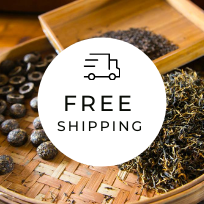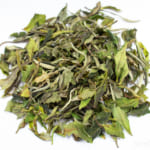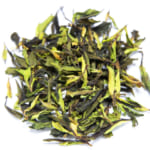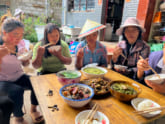- HOME >
- Tea constituents and functional effect
The Real Cause of Astringency in Tea

Many people might think that astringency in tea comes from tannin. The fact is tannin only contributed partially to the astringency. There are two types of root cause of astringency. Besides tannin, the astringency comes from minerals too.
Difference between tannin and poly phenol
Summer or autumn tea is normally astringent. If you drink those teas with empty stomach, your stomach may have very uncomfortable feeling and sometimes you may even feel nauseous.
Many people might think that the astringency is one of the characteristics of black tea. Some of my customers told me that they cannot drink black tea because they have weak stomach. In fact, it has nothing to do with the black tea. Many black teas in commercial tea market are often made from the summer-harvested tea. The summer tea contains very distinctive type of poly phenol called EGCG. This particular poly phenol will conjugate with protein of our body. Because of this reaction, we feel astringency. The substance that have a property to conjugate with protein is classified as tannin group. The term tannin is not referring to the specific substance but a group of substance that gives tannin-ish reaction.
The spring tea contains very less EGCG. Therefore, the spring black tea does not give any uncomfortable sensation in our mouth and stomach too.
Mineral causes dryness on our tongue
There is another kind of astringency in tea. It happens when we drink oxidized tea. This type of astringency never cause problem with stomach but an irritating sensation and results in an immediate dry and chalky feeling in the mouth. Besides oxidized tea, this type of astringency is caused by the tea fried at very high-temperature or tea that is grown with lots of fertilizer or pesticide. This astringency has nothing to do with the tannin. In fact, it is caused by specific type of mineral.
Magnesium = Astringent
A familiar example to understand the astringency caused by minerals is canned drink such as canned beer packed in aluminium causes astringency. If you have a chance to compare side by side the same type of drink between can and glass or pet bottle, obviously the canned drink gives dryness on tongue. It is easily sensed if you compare Coca-Cola from can and PET bottle.
There are a number of minerals such as copper, magnesium, silver, aluminium and zinc that gives astringency. I have studied the effect of each mineral in taste with water and tea. I noticed that the astringency caused by magnesium is exactly the same sensation as oxidized tea. If I add magnesium in green tea, it gives the same type of astringency as the oxidized green tea. Because of this finding, I started to think that magnesium is mainly responsible for the mineral-astringency in tea.
Tea contains a lot of magnesium inside chlorophyll
In fact, tea contains a lot of magnesium. Chlorophyll is the green pigment of tea, and it contains magnesium in the centre of its molecule. Magnesium is part of chlorophyll.
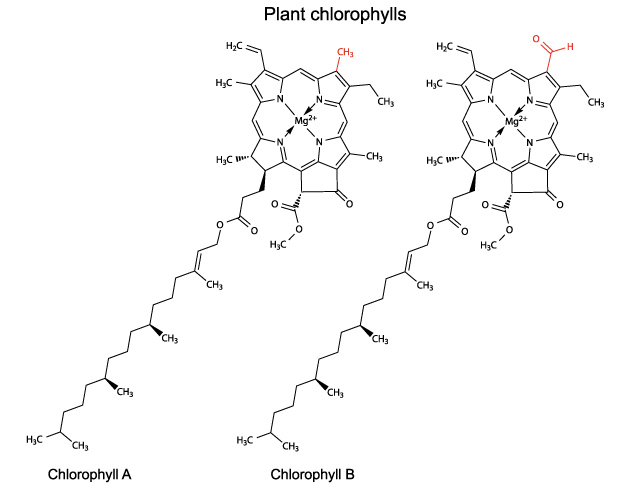
Mg located in the centre of the above molecule is Magnesium.
Chlorophyll is a very unstable substance, which means it is very easily oxidized. Once the oxidation takes place on chlorophyll, it will change into the substance called Pheophytin and magnesium will be released. We do not really get the taste of magnesium when it is bonded with organic substance such as chlorophyll. But once magnesium commes out, it greatly affects the taste. In particular, magnesium gives astringency and bitterness.

Gyokuro Tea Garden
I believe that the reason why the oxidized green tea gives strong astringency is due to the oxidation of chlorophyll. Similarly, the tea pan-fried at higher temperature also becomes astringent. High temperature during frying damages/oxidize chlorophyll and magnesium is released from chlorophyll.
Gyokuro and Matcha contains more chlorophylls than ordinary tea. It is because of these teas are produced under the shade and tealeaf needs more chlorophylls in order to effectively capture the sunshine. Therefore, the oxidized matcha or gyokuro gives much more astringency and bitterness than other teas.
The reason why black tea and oolong is not astringent
Black tea or oolong does not remain the chlorophyll. In these teas, chlorophylls are mostly oxidized and broken. However, black tea or oolong tea is not astringent unless these teas get oxidized. The magnesium in those teas may be forming a complex with other substance being formed during the enzymatic oxidation of poly phenol. Since magnesium does not exist in a free form, it does not contribute to astringent taste.
The reason why the fertilized tea is astringent
One of the reasons why fertilized tea is astringent is related to the amount of chlorophyll. If fertilizer is used, tea trees will grow faster and bigger. Consequently, it synthesizes more chlorophylls and conducts more photo-synthesis. Obviously, the fertilized vegetable or tea are so much greener due to higher content of chlorophyll.

Sustainable Tea Garden kept without fertilizer
On the contrary, the tea leaf of sustainable tea garden is yellow in colour. Because of no fertilizer is used, tea trees grow very slowly and thus it contain less chlorophyll. Tea tree require less photo-synthesis. It could be the reason why sustainable tea gives a clean taste with very less astringency.
Related Articles
How to get the latest update on HOJO Tea?
1. Follow Twitter, 2. Click "Like" on Facebook, and 3. Subscribe in newsletter. You can have the latest tea news from HOJO Tea.
 Subscribe the Newsletter to enjoy the privileges
Subscribe the Newsletter to enjoy the privileges- You may receive a free sample upon purchase, or you may have the priority to purchase special products. So please remember to subscribe our newsletter as well as the social network.
- Yunnan Chun Jian Green Tea from High Mountain Gardens
- Yunnan Chun Jian Green Tea is now available.This tea is made from naturally grown leaves harvested from high mountain gardens at 2100m above sea level. It has a rich, long-lasting lingering aftertaste, comparable to raw Pu-erh tea. Yunnan as a Distinctive Tea Growing Region Over the past 20 years, we have explored a wide range …
- Limited Loose Leaf Release of 2025 Da Xue Shan Wild Raw Pu-erh Tea
- We have released the 2025 loose-leaf version of Da Xue Shan Wild Raw Pu-erh Tea.This tea comes from wild tea trees that grow naturally in the high mountains of Yunnan Province, at elevations above 2000 meters. This year, we were only able to secure a small quantity for retail, and the current release is available …
NEW ARTICLES
 Yunnan Chun Jian Green Tea from High Mountain Gardens
Yunnan Chun Jian Green Tea from High Mountain Gardens- Yunnan Chun Jian Green Tea is now available.This tea is made from naturally grown leaves harvested from high mountain gardens at 2100m above sea level. It has a rich, long-lasting lingering aftertaste, comparable to raw Pu-erh tea. Yunnan as a Distinctive Tea Growing Region Over the past 20 years, we have explored a wide range …
 Limited Loose Leaf Release of 2025 Da Xue Shan Wild Raw Pu-erh Tea
Limited Loose Leaf Release of 2025 Da Xue Shan Wild Raw Pu-erh Tea- We have released the 2025 loose-leaf version of Da Xue Shan Wild Raw Pu-erh Tea.This tea comes from wild tea trees that grow naturally in the high mountains of Yunnan Province, at elevations above 2000 meters. This year, we were only able to secure a small quantity for retail, and the current release is available …
 2025 Da Xue Shan Wild White Tea Now Available from Yunnan
2025 Da Xue Shan Wild White Tea Now Available from Yunnan- The 2025 harvest of Da Xue Shan Wild White Tea is now available. Crafted from truly wild Camellia taliensis trees growing naturally in the high-altitude forests of Yunnan, this tea offers a purity and character unique to its origin. This year’s unusually dry climate during the withering season was ideal, resulting in a floral and …
 Why Do Some Teas Taste Astringent? Exploring the Causes and Mechanisms of Astringency
Why Do Some Teas Taste Astringent? Exploring the Causes and Mechanisms of Astringency- Tea can range from having no noticeable astringency to possessing a very strong one. What causes this astringency? This article explores the causes and mechanisms behind astringency in tea. Causes of Astringency Astringency arises from the binding of tea components to proteins in the oral cavity, creating a sensation of tightness or dryness. The tongue …
 The Impact of Heat Sources on Tea Flavor
The Impact of Heat Sources on Tea Flavor- It is widely recognized that the material of a kettle plays an important role in shaping the taste of water for brewing tea. Yet, an often overlooked but equally significant factor is the type of heat source used to boil the water. Different heat sources, whether gas, electric, charcoal, or wood fire, can impart distinct …
 New Release of High Mountain White Tea
New Release of High Mountain White Tea- We are pleased to introduce our High Mountain White Tea, sourced from a unique tea garden with two key features: 1. Located at an altitude of 2200-2300m2. Completely wild and untended The ideal natural conditions of this garden result in tea of exceptional quality, offering a pure and gentle, nourishing taste. High Altitude and Wild …
 New Release of Da Xue Shan Wild White Tea 2024
New Release of Da Xue Shan Wild White Tea 2024- We have released the 2024 Da Xue Shan Wild White Tea Loose Leaf. This tea was produced under our direct supervision during our stay in Yunnan Province, ensuring meticulous production management on site. Definition of Wild Tea in Yunnan Province People in Yunnan strongly associate Camellia taliensis with wild tea, regardless of where it is …
 New Release of Wild Pu-erh Jasmine Pearl
New Release of Wild Pu-erh Jasmine Pearl- Out of curiosity, we decided to create a jasmine tea based on Da Xue Shan Wild Raw Tea. This resulted in an exceptionally rare tea, not only in Japan but also in China. Custom Production Network for Jasmine Tea At our store, we source various types of base teas from different regions during the spring. …
 2024 Overview: Our Yunnan White Tea Quality, Process, and Weather Insights
2024 Overview: Our Yunnan White Tea Quality, Process, and Weather Insights- One of the teas we’ve been focusing on in Yunnan Province is white tea. Historically white tea has been produced in both Fujian Province and Yunnan Province for a long time. While white tea from Fujian Province is well-managed during processing, we are dissatisfied with the quality of the raw materials due to the use …
 Yunnan’s Hospitality Culture: Expressed Through Meals
Yunnan’s Hospitality Culture: Expressed Through Meals- In China, as a form of greeting, it’s common to say “你吃饭了吗?” which means “Have you eaten?” However, in Yunnan Province, the phrase “吃饭” is often used in various situations, more like “Eat, eat,” serving as an invitation to share a meal. Yet, with prolonged exposure to Yunnan, one comes to understand that these meal …
Shop Info

Address:Lot No. T-215, 3rd Floor, The Gardens Mall, Mid Valley City, Lingkaran Syed Putra, 59200 Kuala Lumpur
Tel: +603-2287-4537
Business Hour: 10am to 10pm
Category
- New Arrival at HOJO Online Shop
- Featured Articles
- Newsletter
- Types of Tea
- Origin of Tea
- Teapot and Tea Equipment
- Tea Column
- How to enjoy tea
- Tea Processing
- How to choose quality tea
- Tea constituents and functional effect
- Safety of Tea
- Foods
- Tea Business Operation
- Hobby and Outdoor Activity
- Ranking of Tea
- Video
- FAQ
- Media Release
Profile

- AKIRA HOJO
- I invite you to experience my tea selections.I was born in Nagano, Japan. In university, I studied agricultural chemistry, and I have the master degree in food science. I worked in Japanese food industry for 10 years. I involved in R&D, QC and QA. As a factory manager, I implemented ISO9000 series and managed the factory.
- The Art of Tea Magazine
- We posted the article on “The Art of Tea Magazine No.9, the magazine is published in Taiwan. We featured some scientific view about the tetsubin
- New Straits Times
- The Malaysian National Newspaper, New Straits Times featured HOJO Tea on 17-Oct-2007.


